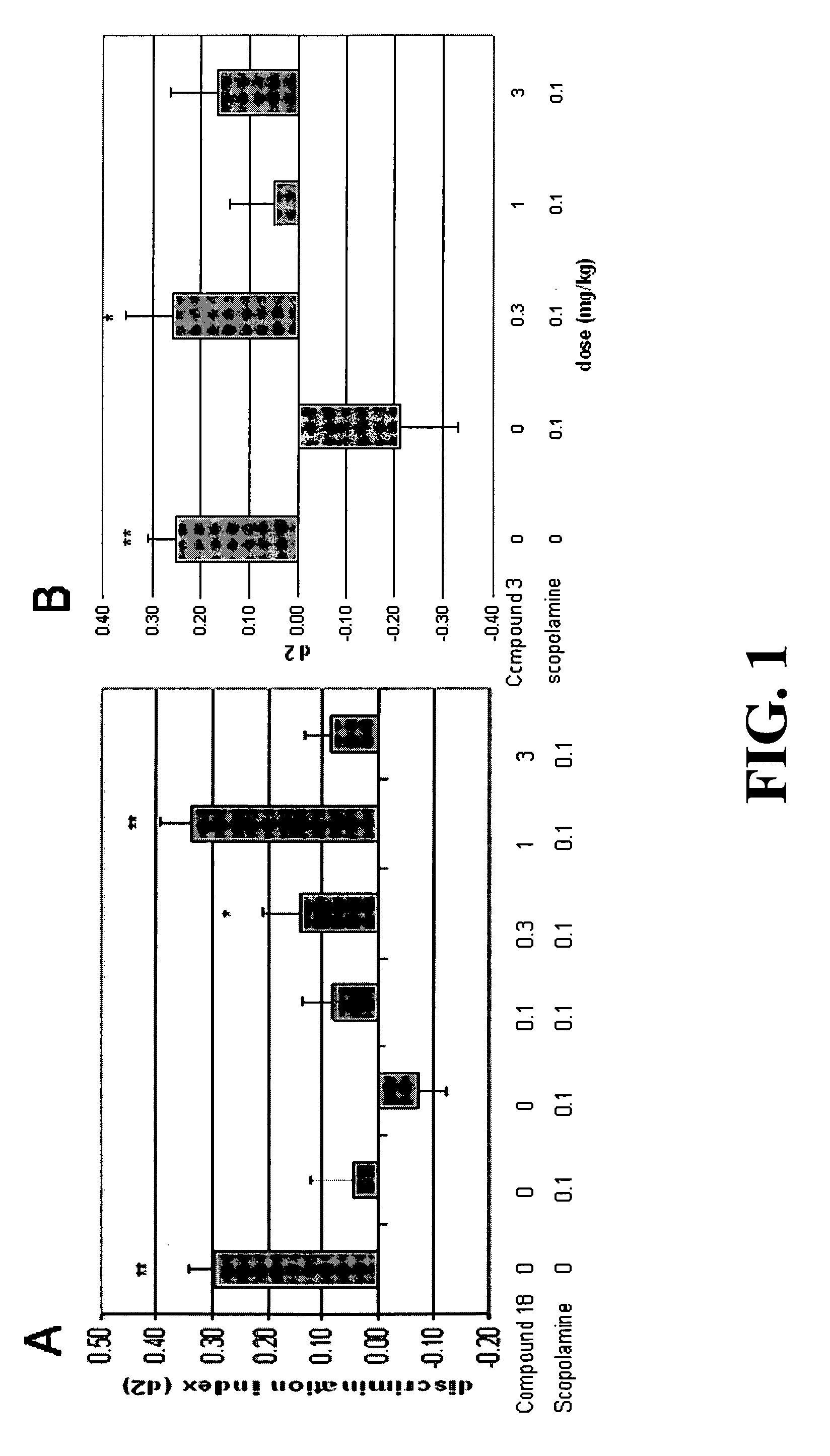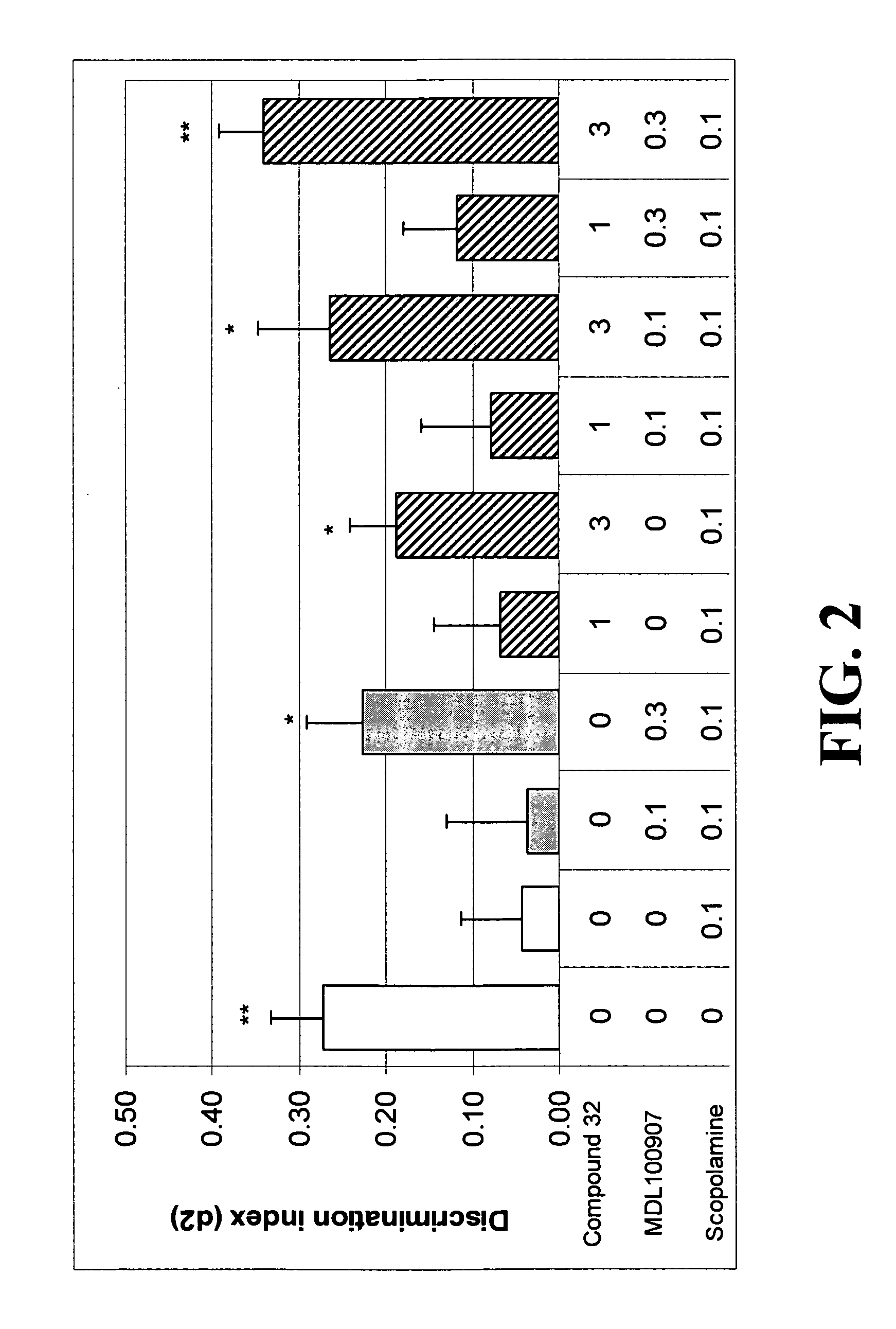Compositions and methods for treating cognitive disorders
a cognitive disorder and composition technology, applied in the field of cognitive disorders and compositions and methods, can solve the problems of not fully understanding the involvement of the 5-ht2a receptor in cognitive functions, affecting the treatment effect of patients, and presenting a major public health problem, so as to reduce the risk of adverse effects, similar or improved efficacy, and lack of efficacy
- Summary
- Abstract
- Description
- Claims
- Application Information
AI Technical Summary
Benefits of technology
Problems solved by technology
Method used
Image
Examples
example 1
Determining Affinity at Human 5-HT6 Receptors
[0187] Ligand affinity at 5-HT6 receptors was determined using competition binding with [3H]-Lysergic Acid Diethylamide (LSD) at membranes derived from HEK-293 cells recombinantly expressing human 5-HT6. In brief, cell membranes prepared by homogenization from HEK293-h5-HT6 cells were incubated with 2.2 nM [3H]-LSD and a range of concentrations of non-labeled test compound for 75 minutes at 37° C. Data were analyzed by non-linear regression to logistic equation (1), and ligand affinity was determined by converting IC50 values so obtained to Ki using the Cheng-Prusoff equation (2) (Cheng & Prusoff, 1973). The affinity of [3H]-LSD determined from separate saturation binding experiments in these membranes was 2.2 nM. bound radioactivity=min+(max-min)[A]IC50+[A]Equation (1)
[0188] Where min and max are the levels of displaceable binding due to the zero and maximal concentrations of unlabelled competitor, A, respectively, IC50 is the mid...
example 2
Determining Function at Human Recombinant 5-HT6, 5-HT2A and 5-HT2C Receptors
[0190] The effect of test compound on the function of human 5-HT6, human 5-HT2A and human 5-HT2C receptors was determined by measurement of changes in intracellular calcium using a fluorescent calcium dye (Fluo3-AM). Fluorescence was imaged on the Fluorescent Light Imaging Plate Reader (FLIPR, Molecular Devices). Changes in fluorescence due to test compound, administered on its own (for assessment of agonist efficacy) or in the presence of 5-HT (for assessment of antagonist potency) were made in HEK293 cells stably expressing human recombinant 5-HT6 receptor fused to Gα16, or CHO-K1 cells stably expressing human recombinant 5-HT2A or human recombinant 5-HT2C receptors.
[0191] In all cases, cells were seeded 12-24 hours prior to the experiment on poly-D-Lysine coated 96-well black / clear plates in DMEM or F12 cell culture media supplemented with 10% Fetal Bovine Serum. Culture media was removed by 4×300 μl e...
example 3
Affinity Determination at the Dopamine D2, Histamine H1, Muscarinic M1 and M2 Receptors
[0194] Ligand binding affinities at the Dopamine D2 receptor were determined using human recombinant D2 receptor as described in Grandy et al., Proc. Natl. Acad. Sci., 1989, 86, 9762-9766. Affinities to the Histamine H1 receptor were determined using guinea-pig cerebellum as described in Dini et al., Agents and Actions, 1991, 33, 181-184. Binding affinities at Muscarinic M1 and M2 receptors were determined using human recombinant M1 and M2 receptors, according to the procedures described in Dorje et al., 1991, J. Pharmacol. Exp. Ther., 256, 727-733.
[0195] The affinity estimates of several exemplary compounds at various receptors are compared to those of the non-selective 5-HT6 / 5-HT2A receptor antagonist compounds, Olanzapine and Clozapine, and are summarized in Table 1.
TABLE 1ReceptorDopamineHistamineMuscarinicMuscarinicAffinity (pKi)5-HT65-HT2A5-Ht2CD2H1M1M2Cmpd 39.88.97.2Cmpd 189.28.77.2Cmp...
PUM
| Property | Measurement | Unit |
|---|---|---|
| particle size | aaaaa | aaaaa |
| diameter | aaaaa | aaaaa |
| height | aaaaa | aaaaa |
Abstract
Description
Claims
Application Information
 Login to View More
Login to View More - R&D
- Intellectual Property
- Life Sciences
- Materials
- Tech Scout
- Unparalleled Data Quality
- Higher Quality Content
- 60% Fewer Hallucinations
Browse by: Latest US Patents, China's latest patents, Technical Efficacy Thesaurus, Application Domain, Technology Topic, Popular Technical Reports.
© 2025 PatSnap. All rights reserved.Legal|Privacy policy|Modern Slavery Act Transparency Statement|Sitemap|About US| Contact US: help@patsnap.com



